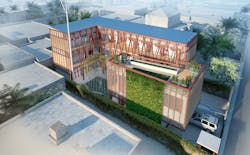How reverse engineering nature can spur design innovation
This post originally appeared on the Fast Co.Exist blog.
Is it possible to really emulate nature? That question powers a new era of design in which the built environment mimics biology’s processes. Reverse engineering is one approach that bridges the gap between designers and nature.
The concept of reverse engineering is simple: take things apart to discover how they function. But reverse engineering devoid of understanding won’t work. Designers aiming to mimic natural systems in the built environment must draw from a deep knowledge of nature’s nuances, from the largest biome to the most specific plant structure.
HOK’s collaborations with scientists–a practice Biomimicry 3.8 calls Biologist at the Design Table, or BaDT–lend context. For example, how does a leaf’s functionality contribute to the rainforest’s larger purpose?
Jamie Dwyer, a biologist and design strategist for Biomimicry 3.8, likens the “biome-in” approach to a puzzle.
More posts at Life at HOK
Q+A: Patrick MacLeamy, HOK’s Chairman and CEO
“We ask, ‘What’s the big picture, what are all of the pieces that make it happen, and what pieces are we trying to mimic?’” Dwyer says. “At the ecosystem level, for example, there are tons of little things that add up to help the rainforest change the atmosphere.”
When we achieve a holistic understanding of the natural world, it becomes a catalyst for design innovation. In Los Angeles, a half-inch of rain produces 3.8 billion gallons of water. But due to runoff, the city must still import 88% of its water. Innovators are taking steps to mitigate the city’s water issues. Andy Lipkis of TreePeople, for example, has developed forest-inspired technologies to help capture rainwater.
Designing an ecologically functioning landscape can only do so much. If buildings are isolated, the landscape falters. A marriage of landscape and built environment should be our goal. Recent HOK projects in Hawaii, San Francisco, and Haiti demonstrate a multidisciplinary approach to mimicking and protecting natural systems at the product, building and city level.
On Oahu’s Ford Island, a new campus for the National Oceanic and Atmospheric Pacific Regional Center links two historic Pearl Harbor hangars designed by Albert Kahn. Set to open in February, the facility includes a tsunami warning center and national marine sanctuaries, protecting its Pacific surroundings while taking inspiration from the ocean. Water from a seawater well cools prevailing breezes and ventilates the building, sans air conditioners or mechanical fans–one example of how we reverse engineered a specific ecological feature while meeting ecosystem needs.
WJCCC Energy Cycle
Similarly, in San Francisco, HOK designers are working on an historic structure: the Museum at the Mint, which was just a few hundred feet from marshland when it was built in the early 19th century. Because we believed water could play a crucial role in our design strategy, we reverse engineered elements of the wetland past.
Local biologists offered context, explaining how native Bay Area plants use precipitation and fog to their advantage. Many ferns and succulents are covered in tiny bumps that capture rainwater, a mechanism we borrowed. The raised screen we designed, outfitted with ceramic dots, provides 100% more surface area for moisture collection–crucial in San Francisco’s Moist Temperate Coniferous Forest Biome.
Not every project offers a clear contextual view. Only 2% of the native forest remains in Port-au-Prince, Haiti, site of the future William Jefferson Clinton Children’s Center. HOK designers, working under strict budget constraints, lacked on-site biologists. To develop our strategy, we gained ecological insight wherever we could: from a relief worker who once worked as a biologist in the area, longtime local families, asknature.org, and our Genius of Biome report.
Haiti’s native kapok tree inspired the WJCCC’s facade.
Haiti’s native kapok tree inspired the building façade. Protecting the building like tree bark, a “boundary layer” will shield exterior walkways and vertical surfaces from direct sunlight while allowing for daylighting and natural ventilation. Likewise, the structure’s branching support system is kapok-inspired, with mother limbs measuring twice the cross-sectional area of daughter limb pairs–a 500-year-old Leonardo da Vinci observation that deepens our context.
Practiced from the biome-in, reverse engineering should result in design that meets community and ecosystem needs. It’s challenging, but necessary to create a bio-inspired built environment.
About the Author

Life at HOK
HOK is a global design, architecture, engineering and planning firm. Through a network of 24 offices, HOK provides design excellence and innovation to create places that enrich people's lives and help clients succeed. Life at HOK is a group blog authored by the firm’s creative people across the world. Visit hoklife.com.
